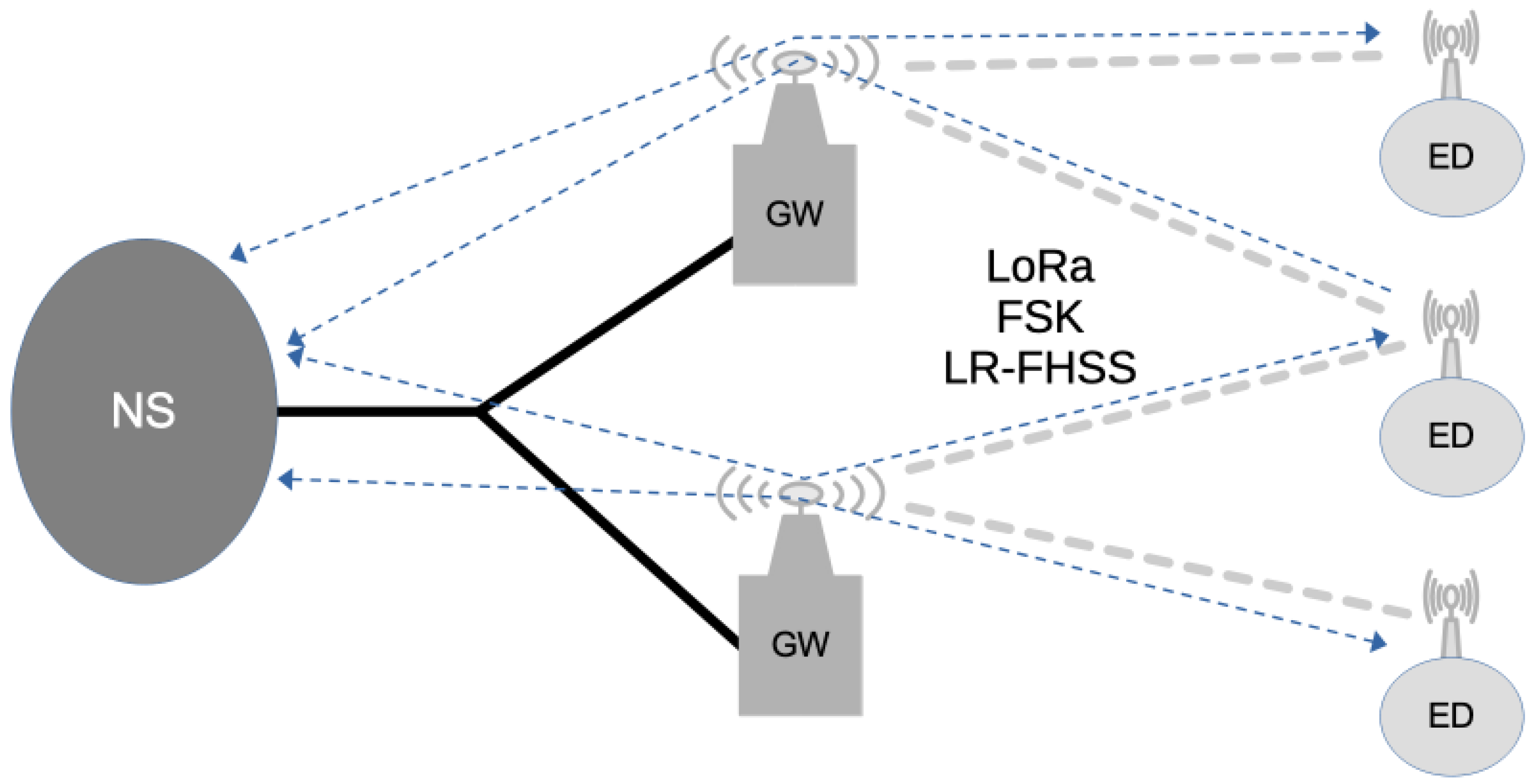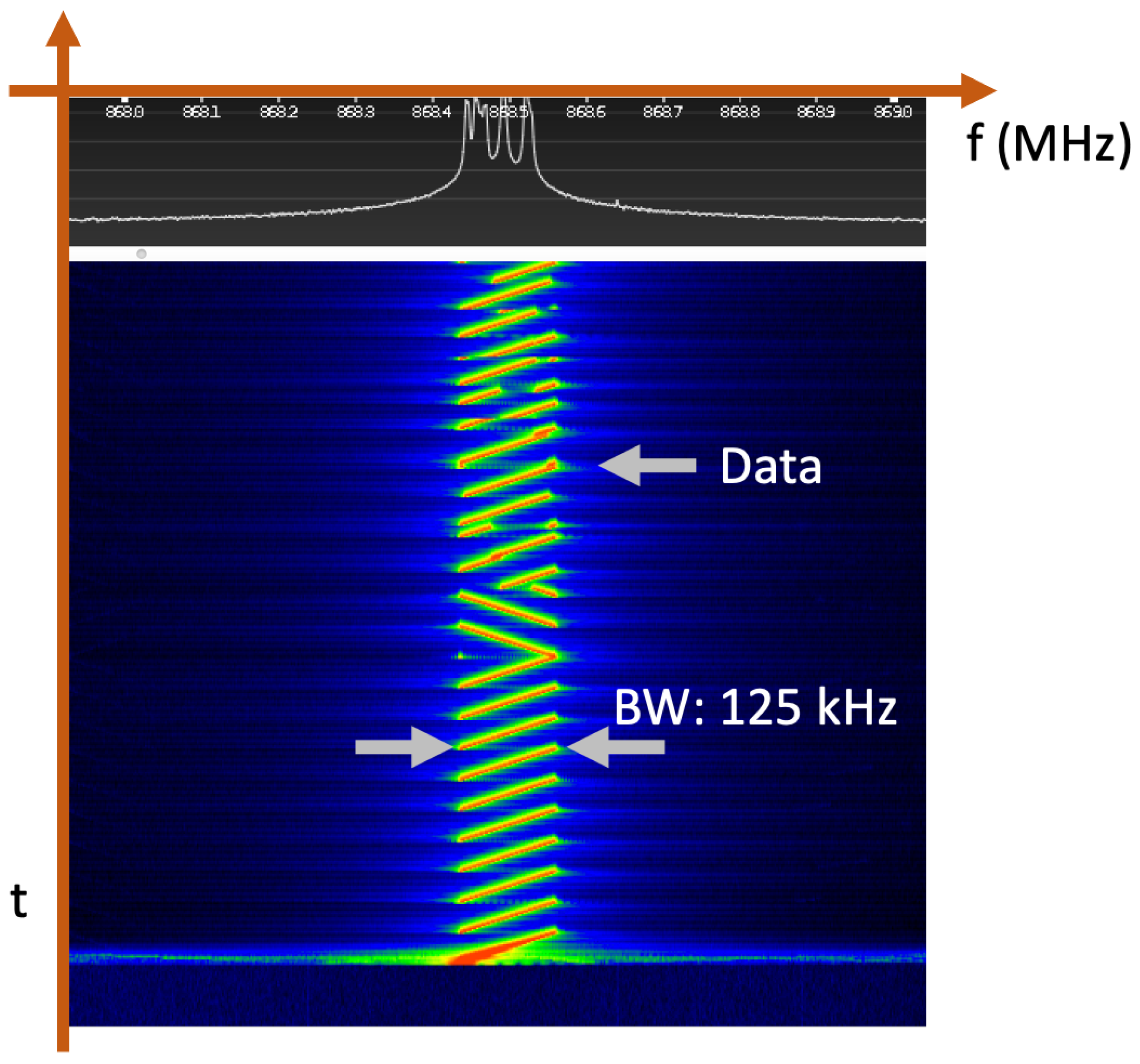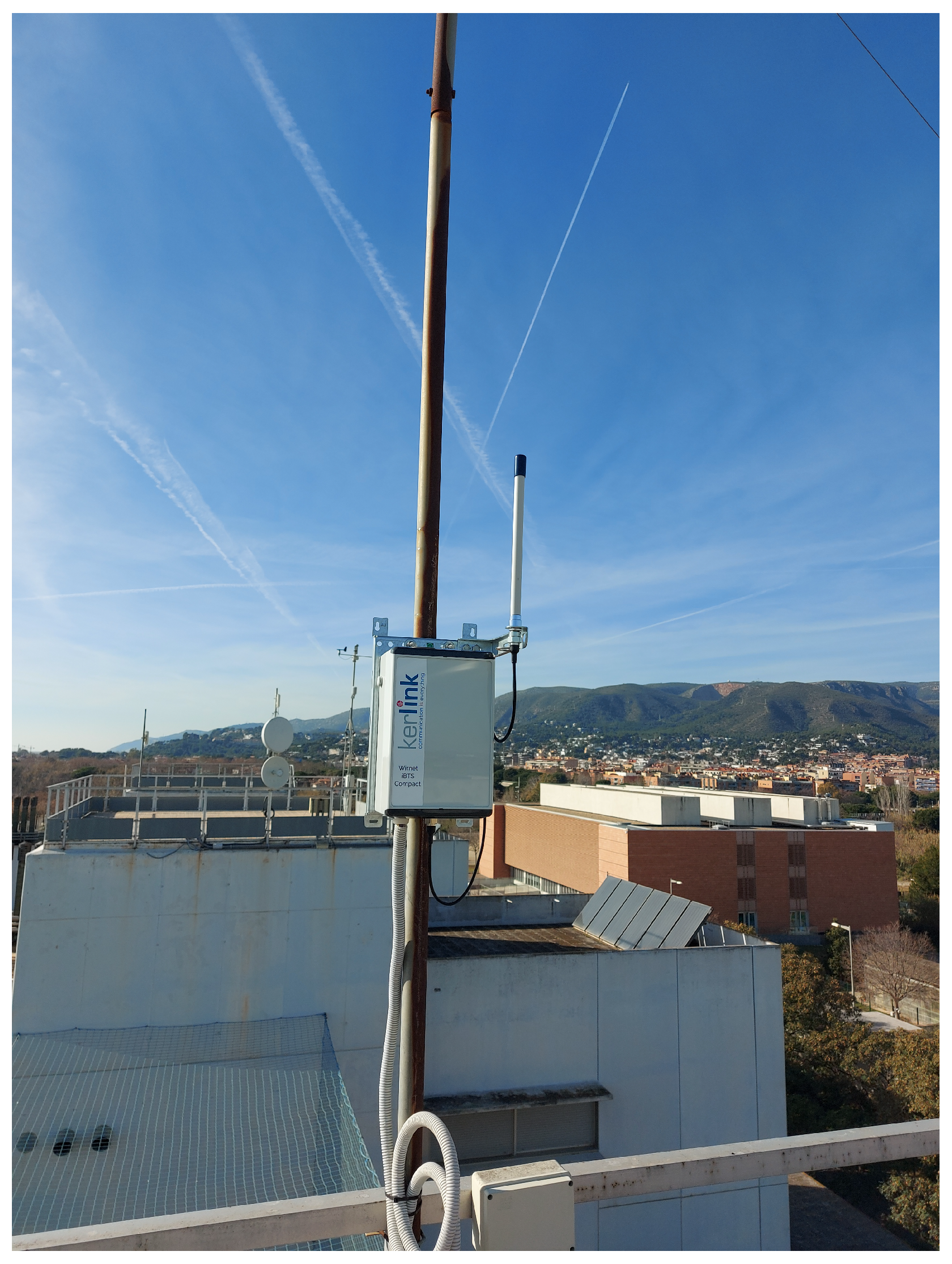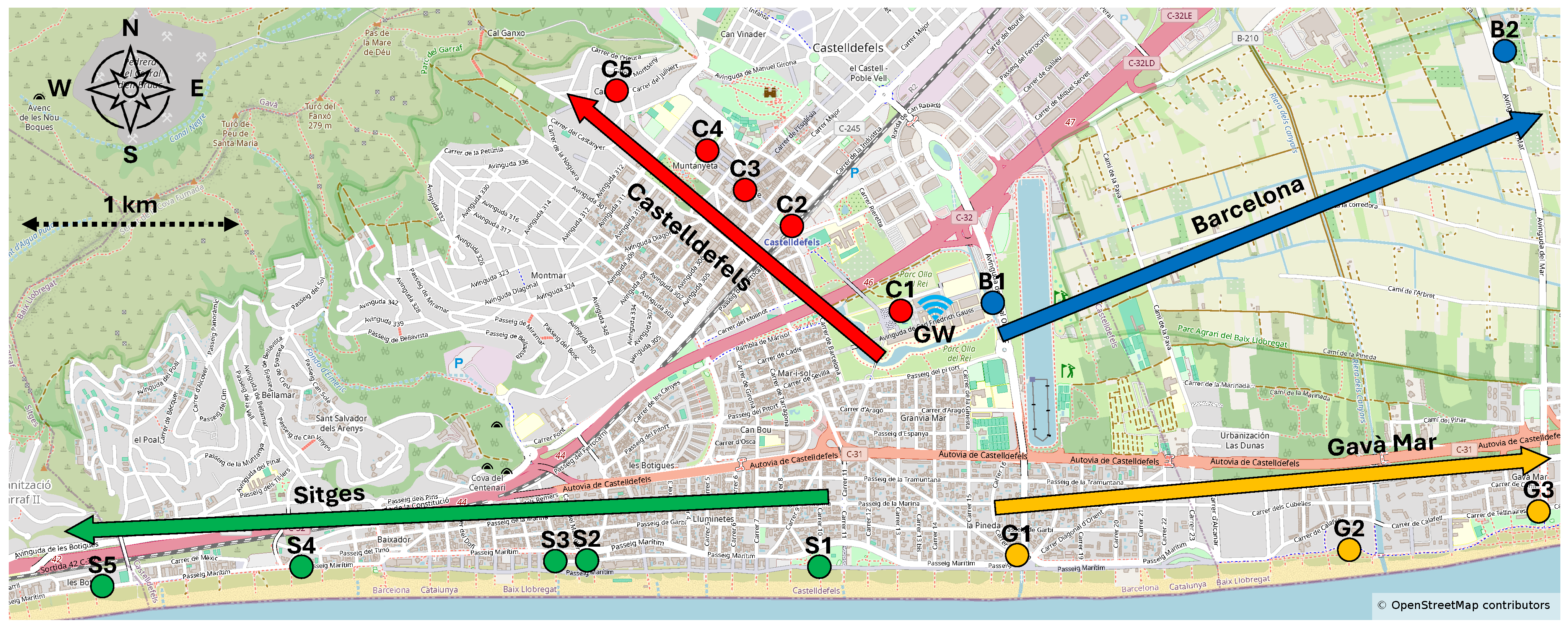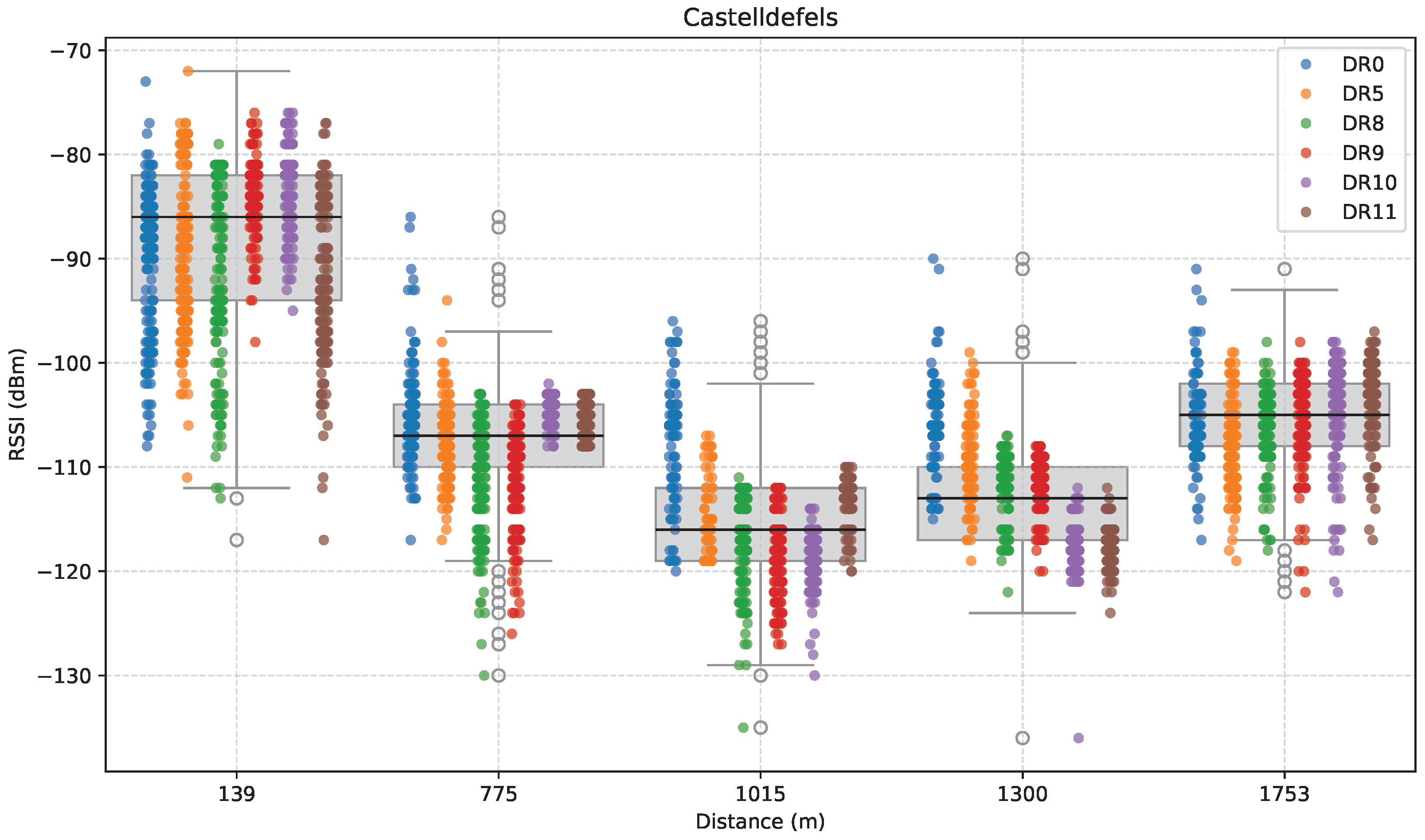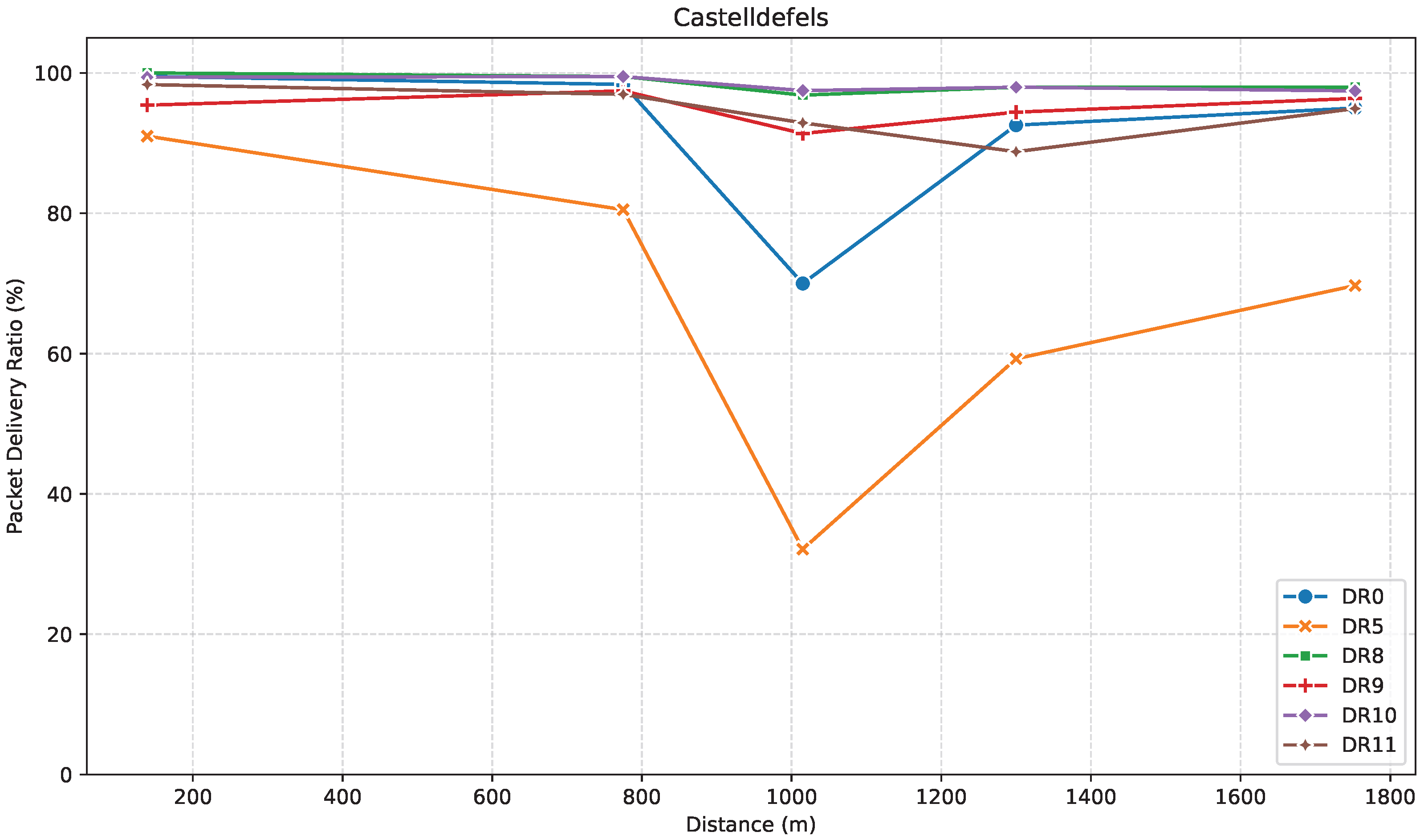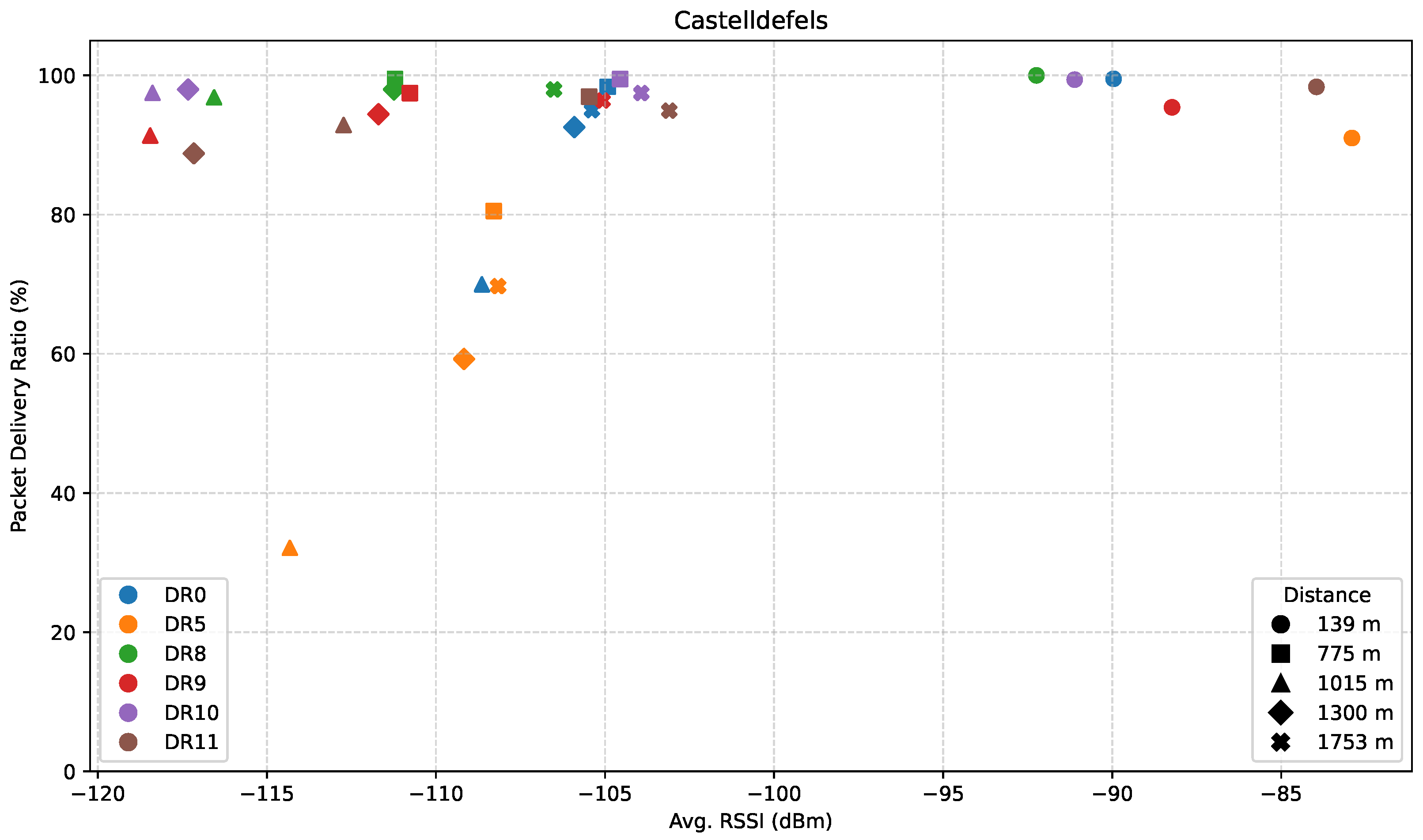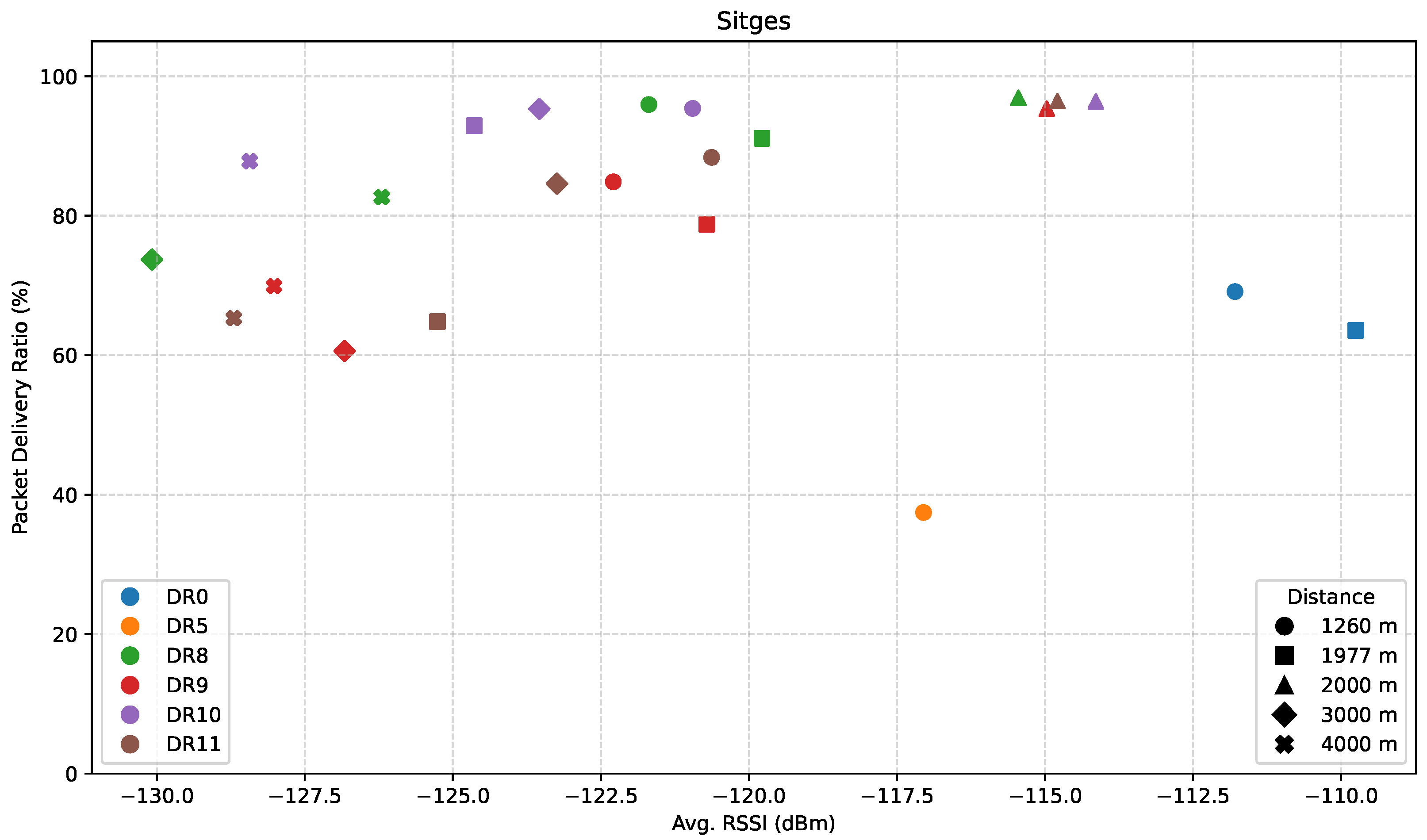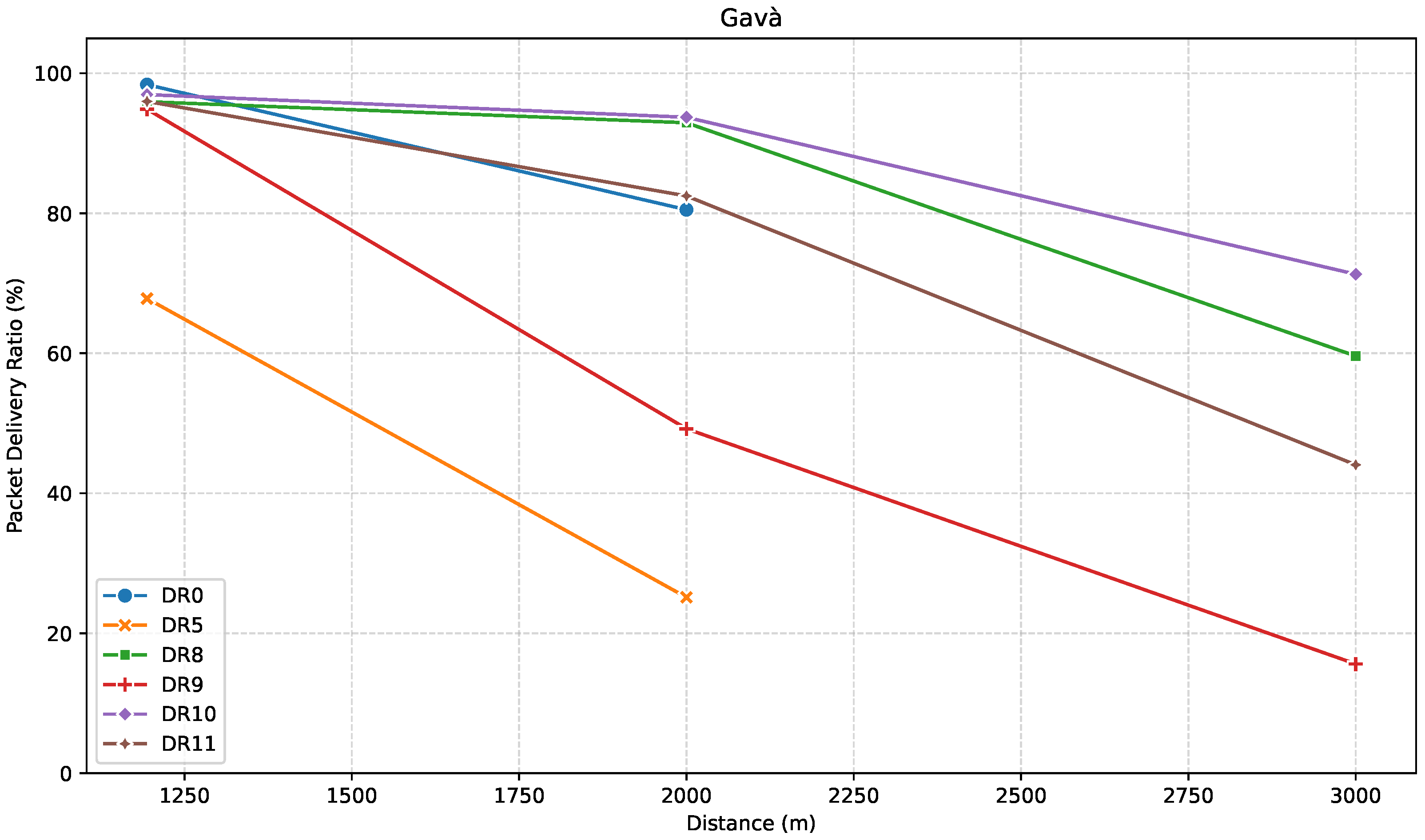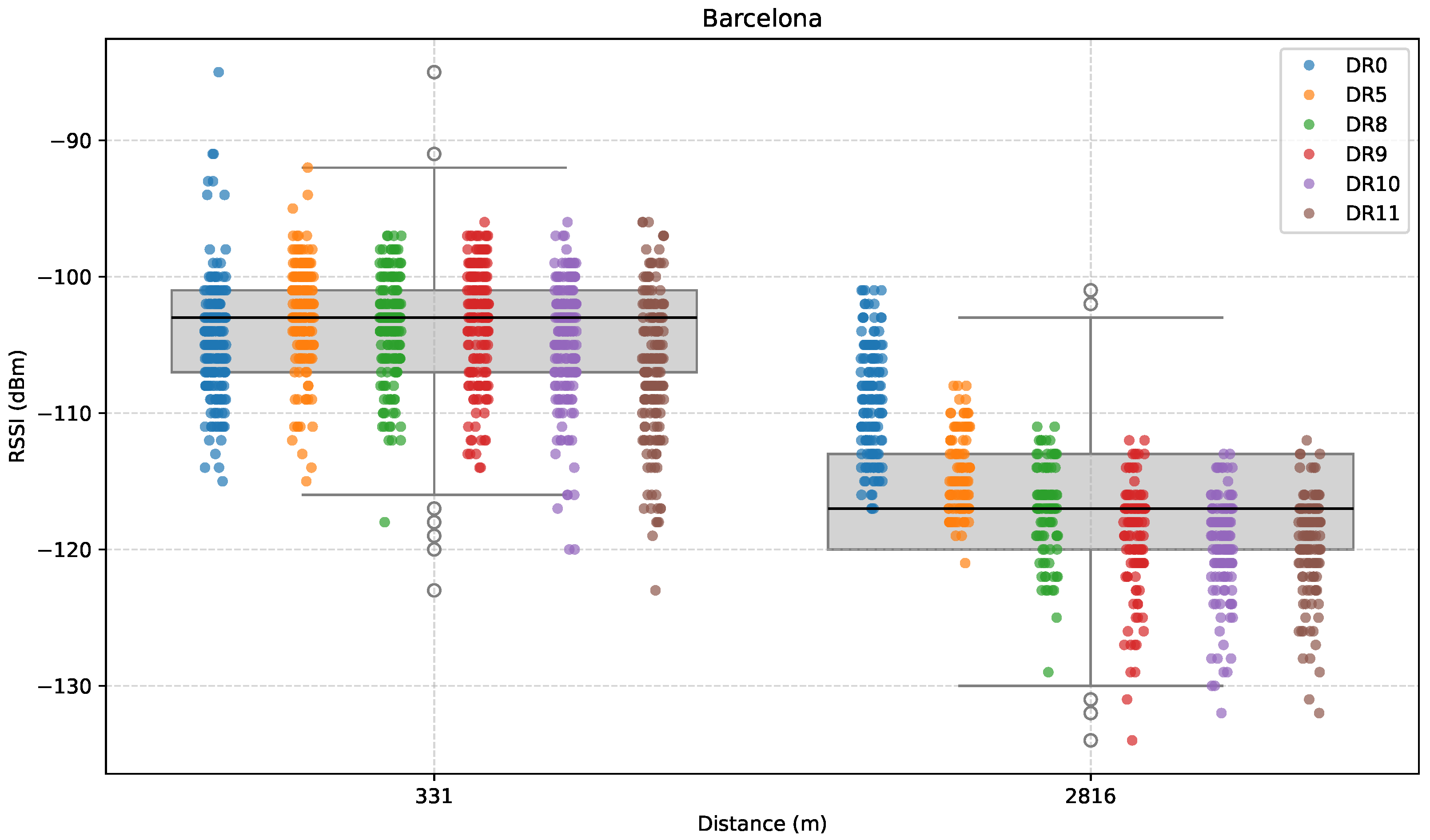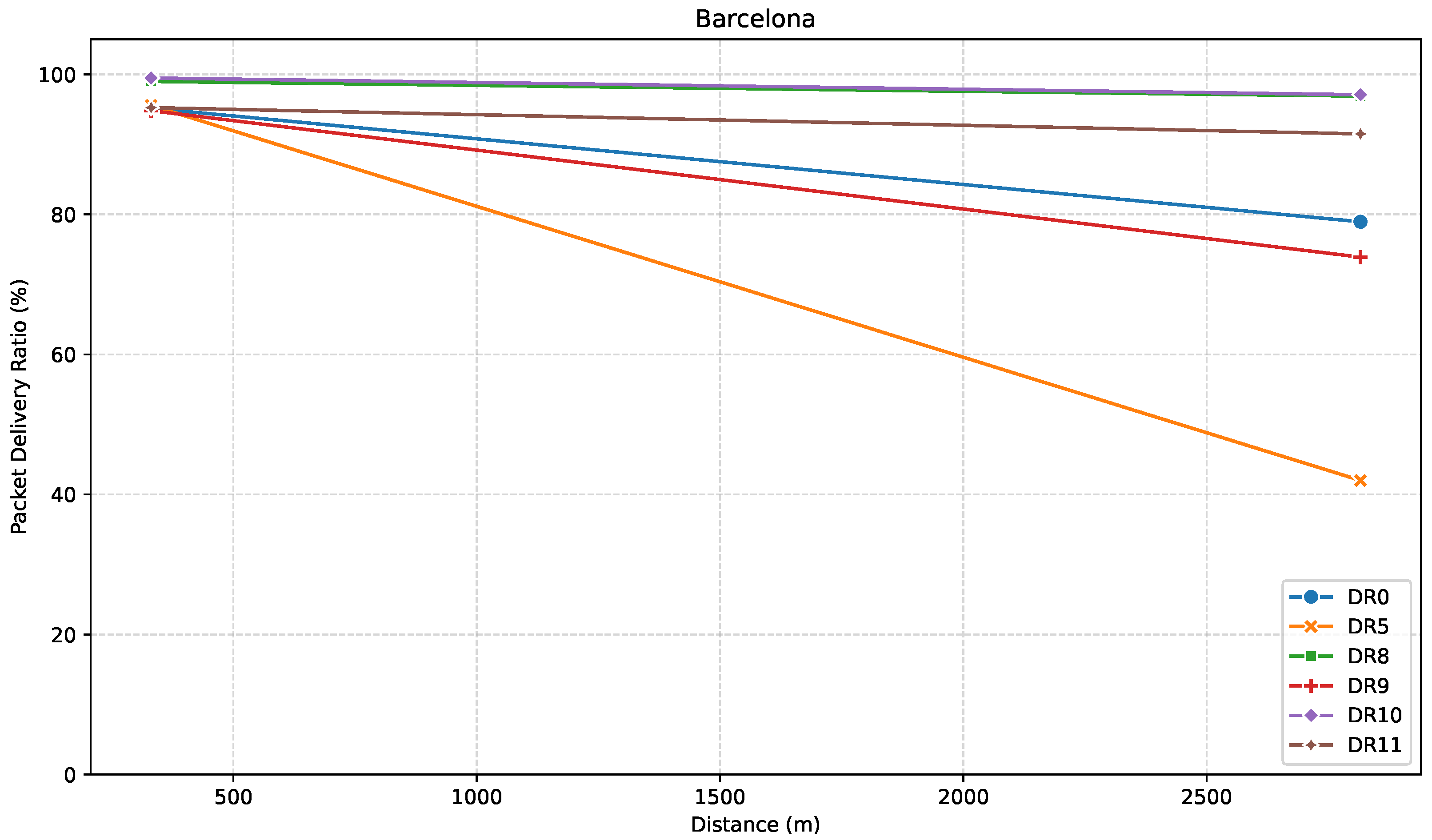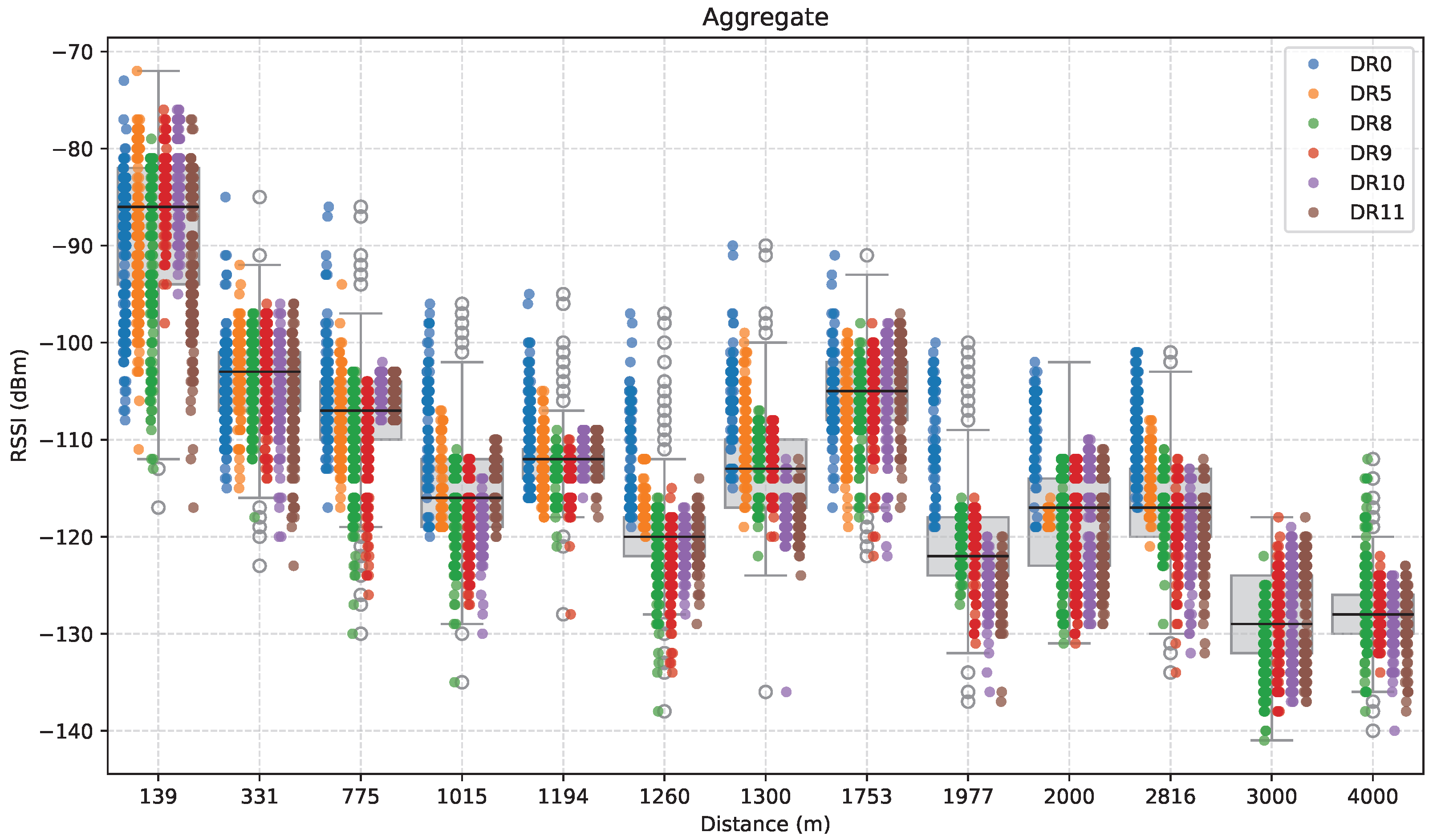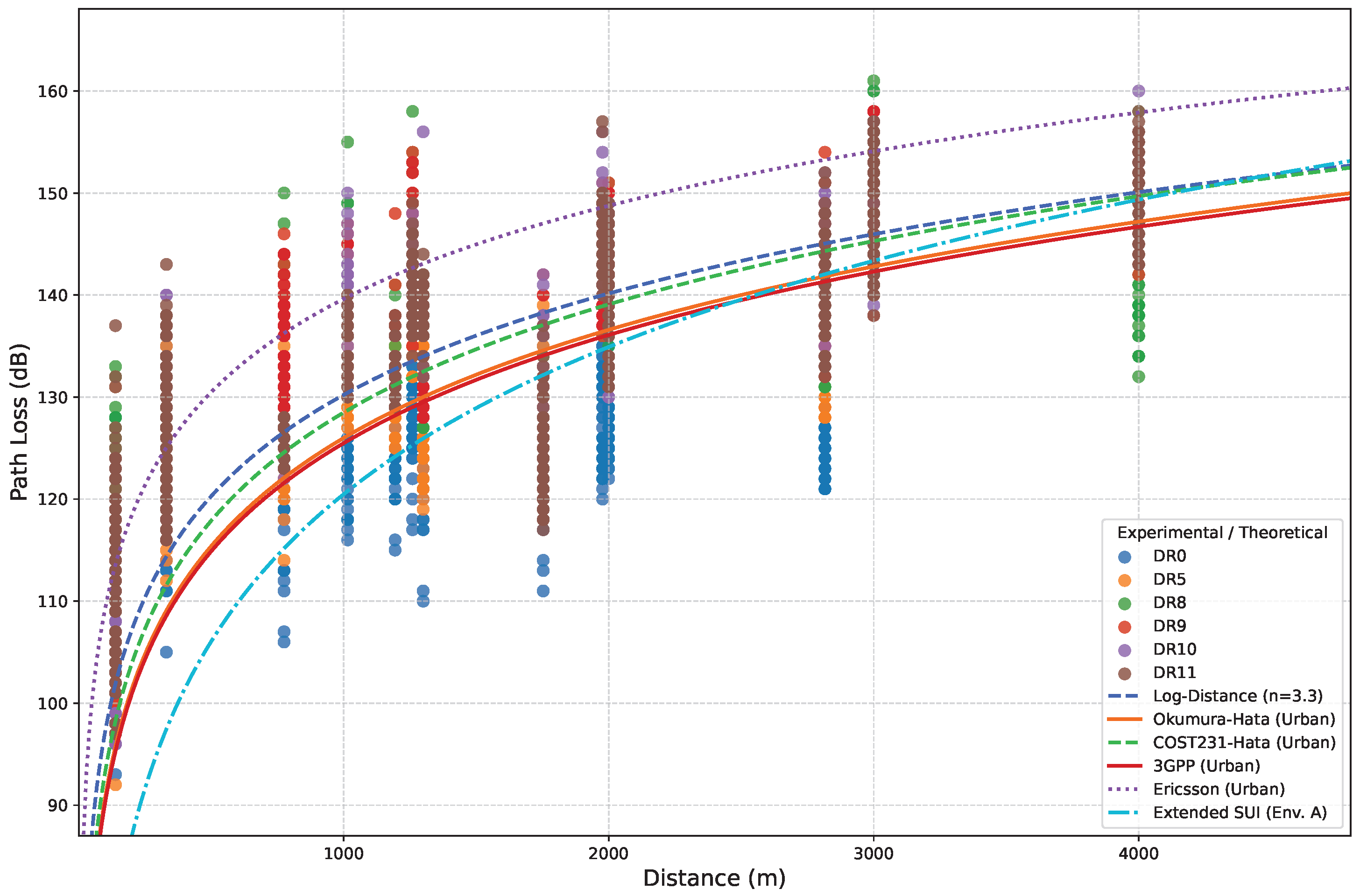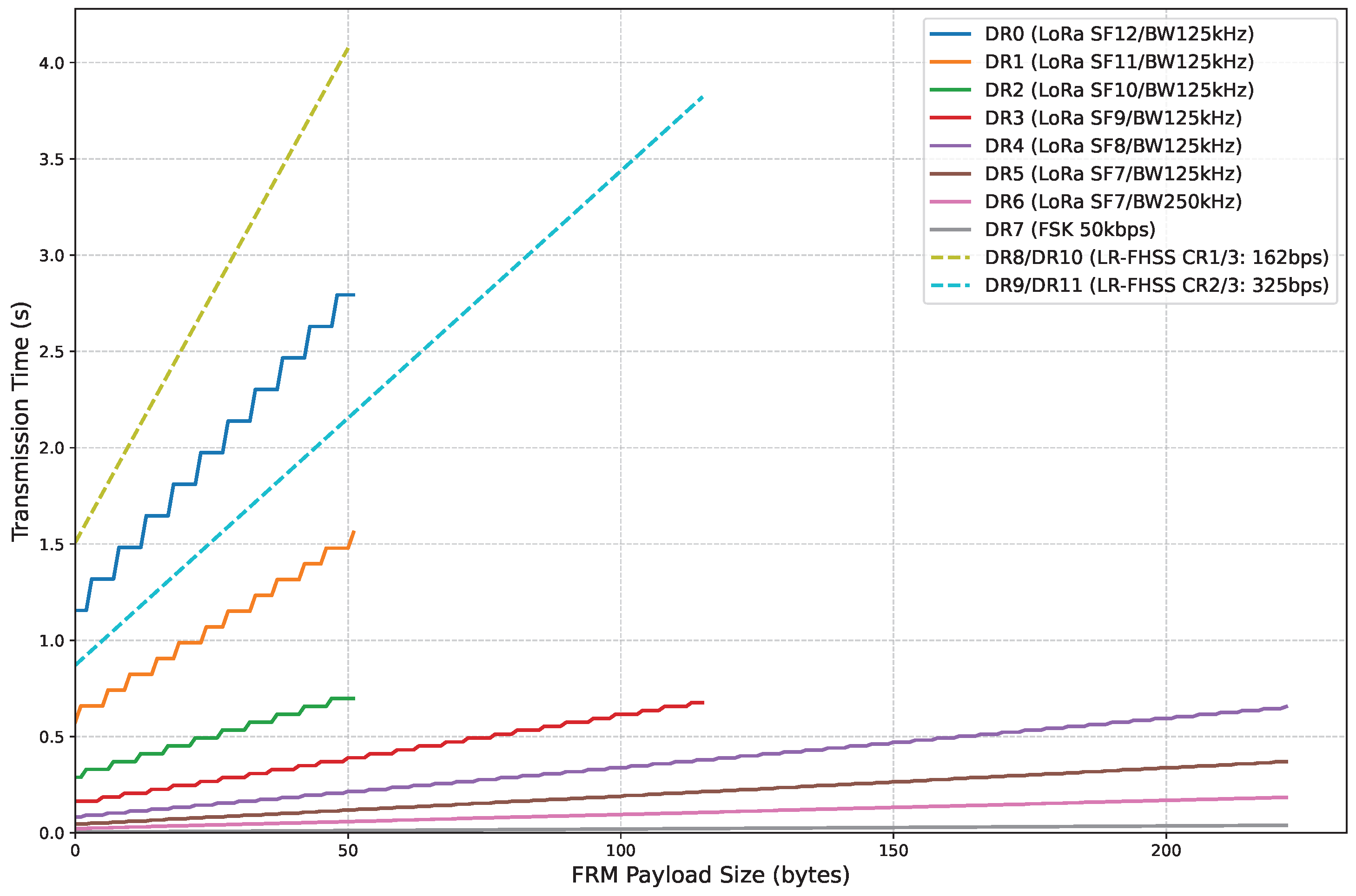This section presents an in-depth evaluation of the performance of both LoRa and LR-FHSS under real-world conditions, more specifically, in urban and semi-urban scenarios. The analysis focuses on an outdoor measurement campaign designed to assess how these technologies behave over various distances between ED and GW, and varying signal propagation environments. The section begins by describing the experimental setup and follows with the experimental results obtained, considering several ED locations along four distinct paths from a GW, focusing on PDR and RSSI, and providing a qualitative discussion of the measured performance along each path. Then, it features a broader interpretation of the measurements through an aggregate analysis, offering a view of how LR-FHSS and LoRa behave regardless of the specific features of each environment. The section concludes with a discussion on the trade-off between link range and latency and energy consumption of the LoRaWAN DRs. As a side contribution of this article, the data collected and used in this study are publicly available (see the corresponding link at the end of the document).
4.2. Scenarios
We performed measurement campaigns, placing the ED in different locations along four directions starting from the GW. This methodology enables a systematic assessment of how LoRa and LR-FHSS perform under heterogeneous environmental and signal propagation conditions, such as line-of-sight (LOS), non-line-of-sight (NLOS), and mixed scenarios.
Figure 5 shows a map with the different measurement points and overlying path directions, towards the cities and areas of Castelldefels, Sitges, Gavà Mar, and Barcelona. At each measurement point, all DRs were tested sequentially, during the same time frame and on the same day.
Table 2 shows the geodesic distances between the GW and the ED locations, as well as ED elevations, organized by direction. Distances range from hundreds of meters to 4 km. We next provide further details and the experimental results corresponding to each one of the four directions considered.
4.2.1. Towards Castelldefels
The first set of outdoor measurements (locations C1-C5) was conducted in the uphill direction from EETAC toward the center of Castelldefels and beyond (northwestward). The urban environment of Castelldefels features low- to mid-rise residential buildings, open street layouts, and moderate vegetation density, providing generally favorable conditions for wireless signal propagation.
The results of this measurement set are shown in
Figure 6,
Figure 7 and
Figure 8. First,
Figure 6 displays RSSI as a function of distance along the measurement path. It is represented by a boxplot that summarizes the distribution of RSSI values at each location, with an overlaid stripplot indicating the individual data points, color-coded by DR.
As shown in the figure, at 139 m (C1), although presenting the greatest variability, RSSI remains high in all cases (with a median value of approximately −86 dBm), as we expected due to the proximity to the GW. Further away, at 775 m (C2), which is located just behind a train station, RSSI decreases overall to a median of around −107 dBm, particularly for DR8 and DR9, reflecting both increased distance and the influence of local obstructions. The significant RSSI variance observed for DR8 and DR9 was attributed to the time-variable passenger density nearby.
Subsequent measurements at 1015 m (C3), located in a centric square, revealed another drop in the overall RSSI performance to around −116 dBm, mainly due to the increased distance and obstacles that contribute to fading. At 1.3 km (C4), despite the greater distance, the median RSSI improved to approximately −114 dBm. The greater RSSI values at this location were likely due to a slight elevation increase, improving the signal strength by increasing Fresnel zone clearance and reducing obstruction and multipath effects in NLoS conditions, as shown by a greater average RSSI.
At the farthest location (C5, 1753 m), the median RSSI of successfully received packets improved again to approximately −105 dBm. Despite the distance increase, the greater elevation improved the communication conditions.
PDR is a key metric to assess communication reliability.
Figure 7 illustrates how PDR evolves with distance for the DRs considered, in this direction.
At C1, PDR remained higher than 90% in all cases. Then, at C2, while the majority of DRs led to around 98% of PDR, DR5 experienced a significant drop to ~80%, most likely due to its lower robustness.
At C3, PDR dropped steeply, this time especially for DR5 to around 32%, but also for DR0 to ~70%. In this case, PDR for LR-FHSS remained mostly stable. Notably, DR0 outperformed DR9 in this environment, possibly due to the lower data rate of DR0 being more robust in noisy or obstructed conditions. A local minimum in PDR around C3 is apparent across almost all DRs. Beyond this point, higher elevation appears to restore or enhance link quality despite the increased distance.
At C4, both LoRa and LR-FHSS generally showed performance improvements. Specifically, the PDR for LoRa DR0 increased back to ~93% PDR, and reached 60% for DR5. At C5, while some RSSI values exceeded those at C2, the corresponding PDR did not necessarily improve, showing that a stronger signal does not always correlate with better link quality. Multipath propagation, shadowing, and other environmental effects may contribute to RSSI values in ways not directly linked to successful packet delivery.
Overall, LR-FHSS DRs (DR8–DR11) maintained PDRs above 85%, demonstrating robust performance even at longer ranges. Among them, DR8 and DR10 performed slightly better than DR9 and DR11, due to more robust coding rates and additional header repetitions that improve resilience under challenging conditions. LoRa DRs, in contrast, exhibited more variable behavior, with DR0 outperforming DR5, which aligns with its higher spreading factor and greater resilience to noise and attenuation.
Finally,
Figure 8 illustrates the relationship between PDR and average RSSI for the DRs considered, in the Castelldefels direction. A general trend is observed in which higher RSSI values tend to correspond to higher PDR, whereas only LR-FHSS maintains high reliability at lower RSSI levels.
LR-FHSS DRs consistently achieve PDR values exceeding approximately 90% even at relatively low RSSI levels. Their ability to maintain high reliability under degraded signal conditions suggests that the underlying modulation and coding schemes are particularly resilient to noise and attenuation, making them well-suited for long-range communications. In contrast, DR5 exhibits a steep decline in PDR as RSSI decreases: while DR8 and DR10 achieve nearly 100% PDR at –117 dBm, DR5 only reaches around 60% even at –109 dBm. DR0 remains more stable, with PDR values ranging from approximately 70% to 98%, but it does not achieve the same level of consistency as the LR-FHSS configurations (DR8–DR11), which maintain high PDR even at lower RSSI values.
4.2.2. Towards Sitges
The second set of outdoor measurements (S1-S5) was carried out following the coastal promenade heading to Sitges (westward). This path runs below the elevation of the university rooftop, where the GW is installed. It is important to note that, although the path is generally characterized by open spaces, there is no direct LoS between the receiver and most of the measurement points along this route. Along the promenade, various vegetation clusters and residential buildings obstruct the path, hampering signal propagation.
Figure 9,
Figure 10 and
Figure 11 depict the results for this direction. First,
Figure 9 presents the RSSI measurements as a function of distance along the promenade. Notably, the distribution of RSSI values across DRs and distances shows that RSSI is influenced not only by distance, but also by environmental characteristics.
The first test point was at a distance of 1260 m from the GW (S1). While both LoRa DR0 and DR5 remained operational at this point, performance had already degraded noticeably in comparison with the Castelldefels direction. Concretely, the median RSSI of successfully received packets was −120 dBm at this point, as opposed to around −114 dBm in C4, where the distance between ED and GW is similar.
Then, we attempted to measure at 2 km. However, at this location, LoRa connectivity, even at its most robust configuration (i.e., DR0), was no longer possible. As a result, an intermediate measurement was conducted at 1977 m (S2) to identify LoRa’s coverage limit in that direction. In this case, the median RSSI expectedly dropped (to around −123 dBm), mainly due to the increased distance.
The following test location was at 2 km (S3), where the median RSSI increased to around −114 dBm, instead of decreasing with distance. This deviation from the expected monotonic RSSI decay strongly suggests the influence of local environmental factors, such as improved LoS (i.e., increased Fresnel zone clearance) and reduced obstruction at this location. Interestingly, this anomaly coincides precisely with the last point at which LoRa DRs were no longer available.
Beyond the 2 km mark, only LR-FHSS DRs were evaluated, as LoRa was no longer able to maintain communication. At 3 km (S4), the median RSSI dropped even further than in S2 to around −125 dBm, due to the increasing distance, and dropped again to approximately −128 dBm at the farthest point of 4 km (S5).
Overall, signal strength generally decreased with increasing distance, as the median RSSI dropped from approximately −120 dBm at 1260 m to around −128 dBm at 4 km. However, a notable anomaly was the one recorded at 2 km (S3), where signal strength appeared stronger than at the previous locations.
Regarding RSSI variability, all measurement points exhibit wide interquartile ranges and extended whiskers. The spread of values, sometimes spanning 20–30 dB at a single location, reflects common real-world conditions such as multipath propagation and a changing environment.
To assess communication reliability across the locations in the Sitges direction,
Figure 10 shows the PDR performance of the tested DRs as a function of distance.
At S1, PDR remained approximately around 90% for the LR-FHSS DRs, but the LoRa ones showed significantly different behavior. For DR0, PDR dropped to around 70%, whereas, for DR5, PDR showed a value of just 37%, indicating that it was nearing the edge of its effective range. At S2, DR5 did not achieve connectivity, but DR0 still showed a PDR of around 64%, a result that was higher than expected considering that DR0 connectivity was lost just a few meters farther in S3. This behavior illustrates the non-steady and environment-dependent nature of LoRa coverage. At S2, PDR values for the LR-FHSS DRs slightly decreased, as expected, due to the increased distance. The only exception was DR11, with a significant PDR decrease to around 65%.
In the third location, S3, only LR-FHSS DRs had connectivity, and the PDR instead increased to a maximum of around 95% for DR8-DR11. This coincides with the unexpected increase in median RSSI that we identified in
Figure 9 at the 2 km point, reaffirming the local trend of better connectivity. Measurements at the more distant S4 and S5 showed that all four LR-FHSS DRs (DR8-DR11) still provided reliable connectivity. This confirmed that, while LoRa failed to achieve connectivity beyond ~2 km in this direction, LR-FHSS maintained effective performance even at double the distance.
Figure 11 illustrates the relationship between the PDR and the average RSSI for this measurement path.
Compared to the Castelldefels direction, the data points in this scenario are noticeably shifted toward lower RSSI values (ranging from approximately −130 dBm to −110 dBm), indicating a generally more attenuated signal environment. Despite the weaker signal conditions, DR8 and DR10 consistently demonstrate excellent performance. These configurations maintain PDR values above 90% across a broad RSSI range, extending down to approximately −122 dBm. This high degree of reliability under adverse propagation conditions further reinforces their suitability for long-range and low-RSSI scenarios.
Conversely, DR9 and DR11 exhibit greater variability in performance. While they remain generally functional, their PDR fluctuates between approximately 60% and 95%, suggesting a moderate decline in robustness compared to DR8 and DR10.
Among the LoRa DRs, DR0 is only present within the highest RSSI range in the dataset (−112 to −110 dBm), where it achieves a moderate PDR of around 60–70%. It does not appear at lower signal levels, implying that its coverage limit was reached earlier in this direction. DR5 performs particularly poorly, with a single data point registering a PDR below 40% at an average RSSI of −117 dBm, showing vulnerability to degradation in weak signal environments.
4.2.3. Towards Gavà Mar
The third outdoor measurement path (G1–G3) stretched toward Gavà Mar (eastward), as shown in
Figure 5. This path runs below the elevation of the university building rooftop, where the GW is installed. Also, there is significant vegetation density and limited LoS due to natural and built constructions.
In the first test point (G1), located approximately 1.2 km from the GW, all DRs, both LoRa and LR-FHSS, were able to establish communication. Specifically, we measured a median RSSI across DRs of approximately −112 dBm, which is mostly greater than for similar distances in previous scenarios. The next measurement was conducted at 2 km (G2), with the goal of exploring the upper limit of LoRa coverage in this direction. As expected, performance degraded compared to the previous point, to a median RSSI of successfully received packets of approximately −123 dBm.
The final test point (G3), located at 3 km, marked the effective limit of LoRa coverage in this direction. The device was unable to complete the Join procedure, even after trying multiple nearby locations. Consequently, measurements at this distance were conducted exclusively using LR-FHSS, which continued to function, albeit with noticeable RSSI degradation compared to the 2 km point. Specifically, we measured a median RSSI of around −133 dBm.
In contrast to the anomalies noted in the Castelldefels and Sitges directions, the Gavà Mar path exhibits a decreasing attenuation profile. The smooth degradation suggests a propagation environment where signal loss is primarily governed by distance, with no significant anomalies in terrain or LoS conditions along the route. LoRa DRs did not have connectivity at G3, while LR-FHSS remained operational, confirming its superior resilience compared to conventional LoRa in challenging propagation environments.
It is worth mentioning that RSSI variability remains significant. At each location, wide interquartile ranges and extended whiskers indicate fluctuations of up to 20 dB.
Figure 13 displays the PDR performance for the ED location points along this route.
Results showed that, at G1, DR0 surprisingly achieved the highest PDR (~99%), outperforming even the most robust DRs of LR-FHSS. The rest of the results followed expected trends, with DR5 showing the weakest reliability, and the relative behavior among LR-FHSS DRs (DR10 and DR8 outperforming DR11 and DR9, respectively) remaining consistent with prior observations.
At G2, while LoRa DR0 still achieved a respectable PDR of 80%, DR5 and DR9 performed significantly worse, particularly DR9, which showed an unexpectedly low PDR of around 50%. The reason for this deviation could not be conclusively determined. However, it illustrates how the variability of real-world conditions may affect communication performance.
Finally, at the farthest point (G3), it is important to highlight that the distributions of RSSI values across all LR-FHSS DRs were nearly identical, yet the corresponding PDR values varied significantly, ranging from 15% to 71%.
A distinctive feature of this direction is the steady decline in link quality observed across all DRs. At G2, LoRa DR5 already drops to a PDR of approximately 25%, signaling it is close to its coverage limits. DR0, by contrast, still achieves around 80%, which is unexpectedly high considering that it completely disappears in G3. This suggests a sudden and sharp degradation in the environment beyond that point. Even LR-FHSS DRs show performance degradation in this scenario. DR9 is the most affected, falling below 20% PDR at 3 km, while DR11 drops to around 45%. Even the more robust DR8 and DR10 experience a significant PDR reduction, albeit to a lower degree. These results explain the limited coverage potential in this direction, even for LR-FHSS, highlighting the impact that specific paths can have on system performance.
Finally,
Figure 14 presents the relationship between PDR and average RSSI for the path towards Gavà Mar.
In contrast to the previous directions, this environment appears particularly challenging, with average RSSI values as low as −132 dBm. The figure illustrates a clear stratification in performance between modulation schemes under such adverse conditions. As observed in previous directions, DR10 and DR8 once again emerge as the most robust settings, maintaining PDRs above 90% even at weak RSSI levels. However, their performance begins to degrade when the distance increases to 3 km.
DR11 demonstrates moderate reliability, achieving PDR values close to 97% at stronger signal levels, but its robustness decreases sharply with lower RSSI. Under the same conditions, DR9 exhibits significantly poorer performance, with a PDR dropping as low as 15%. This suggests it is particularly vulnerable to signal attenuation and unsuitable for operation in such long-range, obstructed paths.
DR0 achieves a high PDR (above 80%), but it is only recorded within the strongest portion of the RSSI range, and it is absent on the weaker side, confirming its limited coverage. DR5 remains the least robust configuration, with PDR values consistently low (~25% to ~68%), confirming its limited practical value in outdoor deployments under weak signal conditions.
4.2.4. Towards Barcelona
The fourth and final outdoor measurement (B1, B2) path followed the direction toward Barcelona (northeastward), as shown in
Figure 5. In this direction, the area presents mostly unobstructed conditions, with sparse, low-rise buildings and few significant obstacles to signal propagation. However, vegetation is quite dense due to the presence of farmland.
In the first test point (B1), results were as expected for a distance of hundreds of meters, and without significant obstacles: a notable median RSSI of successfully received packets of around −104 dBm. At the second test point (B2), RSSI takes an expected drop to −116 dBm due to the significantly increased distance, plus the effect of dense vegetation between ED and GW.
Overall, as expected, RSSI values tend to decrease with distance. Although variability in the results is around 25 dB, the difference between median RSSI values is around 14 dB, which is not that large considering a 2.5 km distance difference. This could be explained by the LoS characteristics of the path.
Figure 16 illustrates PDR over distance. Results show that at B1, LR-FHSS performs the best overall, with DR10 reaching nearly 99.5% PDR and DR8 not far behind, at 99%. The rest of the DRs provide slightly lower, but still high, and very similar PDR values. Interestingly, LoRa DR5 slightly outperforms DR0, which is unusual given the typically better performance of DR0.
Further away, at B2, performance differences become much clearer. LoRa DRs are noticeably affected, with DR5 dropping to a PDR of just 42% and DR0 achieving around 79%. On the other hand, LR-FHSS DRs perform much more reliably. DR10 maintains excellent performance with a PDR of 97%, and DR8 follows closely at 97%. Remarkably, while DR9 achieves only 74%, it still outperforms LoRa DR5 but falls behind DR0. DR11 performs better than DR9, reaching a PDR of 91%, which may be attributed to its use of a greater number of hopping channels, even though it shares the same modulation settings as DR9.
Figure 17 presents the relationship between PDR and average RSSI for the path towards Barcelona.
Results show that for B1, all points yield both a good average RSSI of around −104 dBm, and a PDR near 100%. For the farthest point, B2, however, despite a significant drop in signal strength of more than 10 dB in most cases, LR-FHSS DRs continue to deliver strong PDRs, especially DR8, DR10, and DR11, which further validates their suitability for long-range communication.
4.3. Aggregate Performance Analysis
This subsection presents an analysis of the aggregate performance of LoRa and LR-FHSS in terms of RSSI, path loss, and PDR as a function of distance, and PDR as a function of RSSI, based on the gathered field measurements from all scenarios. This analysis allows us to study the results regardless of individual directions, see how well each DR handles weak signals, and how consistent the connectivity is at long distances.
4.3.1. Aggregate RSSI Versus Distance
Figure 18 presents the aggregate RSSI measurements as a function of distance, combining all obtained data regardless of direction or path.
As expected, the median RSSI of successfully received packets follows a generally decreasing trend with distance, although with fluctuations, illustrating typical path loss behavior in realistic wireless communication environments. There is also high dispersion of values observed at each distance, which highlights the influence of environmental variability on the measured RSSI values. Although distance is a dominant factor, conditions such as obstructions, elevation, and multipath propagation have a significant impact on the received signal power.
Some ED locations stand out from the general trend. For example, at 1753 m (and similarly at 1300 m), the median RSSI is notably higher than at some of the shorter distances. These deviations, already observed in the path-specific plots, are consistent with the improved visibility between the ED and the GW at the corresponding locations. On the other hand, LoRa DRs lose connectivity beyond ~3 km, while only the LR-FHSS ones remain operational.
To thoroughly characterize the experimental results,
Figure 19 compares the measured path loss with several prevalent theoretical propagation models for LPWAN technologies, adapted to urban environments [
36]. The models considered include Okumura-Hata, COST231-Hata, 3GPP, Ericsson, extended Stanford University Interim (SUI), and the standard log-distance model. For the log-distance model, we fitted the propagation coefficient by testing different values of
n and selecting
n = 3.3, which yielded the lowest Mean Squared Error (MSE) with respect to our empirical measurements. Note that the selected path-loss exponent value (
n = 3.3) corresponds to a shadowed urban environment, characterized by predominantly LoS propagation with intermittent obstructions (e.g., buildings and other structures) [
37]. This aligns with the conditions of our experimental environment, as detailed in
Section 4.2.1,
Section 4.2.2,
Section 4.2.3 and
Section 4.2.4.
The Ericsson and the extended SUI models poorly predict the behavior of the presented scenarios, resulting in the highest MSE values. The Ericsson propagation model yields an overestimation of path loss due to its inherent calibration for high-density urban settings. Furthermore, while the extended SUI model in its environment A variation demonstrates the best performance among the three (A, B, and C) due to its generalized characteristics for hilly, dense foliage terrain, it is still not appropriate to accurately model our test environment, which consists of a mixed urban, suburban, and coastal landscape. Conversely, the remaining four models provide more accurate path loss predictions, particularly for distances close to 1000 m and beyond. Among them, the fitted log-distance model achieves the lowest MSE, closely followed by the COST231-Hata model. This result indicates that the calibrated log-distance model offers the most accurate mathematical representation of the propagation conditions observed in our specific experimental scenarios.
4.3.2. Aggregate PDR Versus Distance
Figure 20 shows the aggregate PDR as a function of distance, for all measurement paths and DRs considered, with 95% confidence intervals. This plot provides a global overview of the communication reliability over varying distances in all the scenarios in this study.
PDR tends to decrease with distance, reflecting the weakening signal strength observed in
Figure 18. However, PDR strongly depends on the specific location associated with each considered distance and the configuration used. Specifically, 1300 m and 1753 m locations present a PDR increase that deviates from the general inverse relationship between distance and signal quality. These localized performance improvements are directly attributed to enhanced LoS visibility between the ED and the GW, confirming that path-specific characteristics, rather than distance alone, influence data delivery success. The performance gap between different DRs becomes particularly evident beyond 2000 m, where some configurations maintain high delivery rates while others exhibit significant degradation. The observed results allow for the classification of the tested DRs into three distinct tiers: DR10 and DR8 (high reliability), DR11 and DR9 (medium reliability), and DR0 and DR5 (low reliability).
In the high-performance tier, DR10 exhibits the highest reliability across all tested distances. It maintains a PDR above 95% up to 2000 m, and its PDR remains above 85% even at 4000 m. DR8 performs comparably to DR10 at short and medium ranges. Although its performance dips around 3000 m, it recovers to exceed 80% PDR at 4000 m, indicating its suitability for extended coverage. DR10 delivers the most robust long-range performance, not only due to its lower transmission speed and stronger coding rate and redundancy, but also likely because it utilizes a wider range of frequency sub-carriers, compared to DR8.
In the medium-performance tier, DR11 delivers high reliability up to approximately 2816 m, after which its PDR declines sharply, reaching around 65% at 4000 m. This makes it a suitable choice for mid-range deployments, though it is less effective for edge-of-network coverage. DR9, in contrast, maintains stable performance at short distances but exhibits a marked decrease in PDR at 3000 m, dropping below 40%. Furthermore, the variability of results increases substantially, suggesting inconsistent performance. Overall, the results indicate that higher transmission bit rate and lower transmission redundancy reduce robustness, compared with DR10 and DR8, although this effect is less pronounced in DR11 due to its larger number of usable sub-carriers.
Finally, in the low-performance tier, DR0 demonstrates relatively good performance at short distances; however, it fails to maintain connectivity at ~3 km and beyond, indicating its limited suitability for long-distance communication. DR5 exhibits the lowest overall reliability, with PDR values declining rapidly and often falling below 40% even at moderate distances. Consequently, this DR is unsuitable for applications requiring high reliability over medium to long ranges.
The results highlight the critical role of DR selection in network design, especially in scenarios involving long-range communication or challenging environmental conditions. The performance differences among DRs are not solely attributable to transmission bit rate, since DR0 operates at a lower data rate than DR9 or DR11, but also to the underlying modulation scheme (LoRa or LR-FHSS), and the corresponding transmission redundancy.
4.3.3. PDR Versus RSSI
Figure 21 illustrates PDR as a function of the average RSSI, for all DRs considered, with 95% confidence intervals. This figure shows how each DR performs in terms of average RSSI, regardless of the specific propagation phenomena that produce the corresponding RSSI values.
A clear pattern emerges across all DRs: assuming an initial high RSSI value, as the average RSSI decreases, the PDR remains consistently high until a specific threshold is reached. Beyond this point, the PDR drops noticeably. This phenomenon represents the sensitivity limit of each DR. The exact value of this threshold varies significantly across the tested DRs. The PDR degradation with decreasing RSSI is more pronounced for less reliable DRs: the greatest slope occurs for DR0-DR5, it is lower for DR11-DR9, and the lowest is offered by DR8-DR10. It is noteworthy that said degradation is not monotonic over distance; particularly, at the average RSSI points that correspond to ED locations at 1300 m and 1753 m, PDR increases instead of steadily decaying. These localized PDR enhancements can be attributed to the increased ED-GW LoS visibility, which effectively mitigates detrimental channel impairments such as multipath fading and shadowing at these specific locations.
Among all configurations, DR10 demonstrates the greatest tolerance to weak signal conditions. It maintains a high PDR, even above 90%, at average RSSI values as low as −125 dBm. This behavior reflects its suitability for long-range communication and challenging propagation environments, where signal attenuation is substantial. DR8 shows a similar performance profile, maintaining high reliability well into the low average RSSI region, closely tracking DR10’s performance across the entire range.
DR11 also performs reliably, although its tolerance to signal degradation is slightly lower. PDR values remain high when the average RSSI is above approximately −120 dBm, but start to decrease noticeably below this threshold. While still suitable for most scenarios, DR11 may become less reliable in the weakest signal conditions encountered at the edge of coverage. In contrast, DR9 exhibits a more abrupt drop-off. While it performs well when the average RSSI is stronger than around −118 dBm, its reliability declines steeply beyond this point, resulting in significantly lower PDR values. This sharp transition limits its effectiveness in environments where consistent signal strength cannot be guaranteed.
DR5 performs poorly under weaker signal conditions. It displays reduced reliability even at moderate average RSSI levels, with visible fluctuations and a general tendency toward low PDR values for average RSSI values below −110 dBm. This suggests that DR5 lacks the robustness required for operation in many real-world scenarios, particularly those involving NLoS propagation or long distances.
